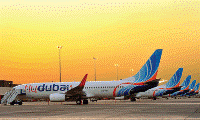Efforts to develop the low-cost carrier market in the Middle East continue with two of the region’s players, UAE carriers Air Arabia and FlyDubai, mapping further growth.
The Middle East remains one of the least penetrated markets by the low-cost carriers with just a handful of local operators, while overseas carriers only touch at the fringes of the market. Ghaith Al Ghaith, chief executive of UAE carrier FlyDubai points to low-cost carriers holding just a 7% share of all traffic in the Middle East region – a fraction of the levels already seen in Europe and North America.
FlyDubai is itself little more than a year old but already operates nine Boeing 737-800s to 22 destinations and will roughly double in size over the next year. “There is an enormous untapped potential in this region,” he says. “When you look at the region, the GCC, the Middle East, the sub-continent, parts of Russia, and some parts of Africa; that is a huge unserved part of the world that we can operate from. For us we are just in the beginning. There are plenty of places to go,” he says.
But Al Ghaith acknowledges, that while there remains opportunities to expand in the mid-term, the pace of its growth in the longer term will be dependent on further relaxation of open skies agreements and travel visa restrictions in the region.
FlyDubai a year on |
|---|
 |
Chief executive Ghaith Al Ghaith expects FlyDubai to double in size over the next year and be profitable in 2012. Launched in June 2009 , it already operates nine Boeing 737-800s and 22 destinations. Four more aircraft will arrive this year.“I think most likely we will double in size [in the next year] and we will continue to grow at an acceptable volume from there onwards, until 2016 when we have all our aircraft,” says Al Ghaith. It has 48 more 737s on order running and has just secured financing on its deliveries to June 2011. “We like other airlines have to look to the market for funding,” he says. “We have just completed our latest round of funding and were pleasantly surprised by the interest we received from the market. I believe it is a sign that Dubai as a whole has turned around and is stepping out of the financial crisis the world has been in.” The airline was established by the Dubai Government and Emirates was charged with helping it launch operations. But Al Ghaith is at pains to stress the carrier is independence from Emirates. “We are grateful to Emirates, but FlyDubai is now a completely separate and independent airline. We offer a completely different airline product at a different segment of the market.” He also says the airline is on course to reach profitability in 2012. “We said we would be profitable in year three and we are on track.” |
“We have taken the low-cost experience model and tried to adapt it to our environment. And we are pleasantly surprised by how many people have adopted the idea of it," he says. “We have some positives differences and some negatives. The fact you don’t have secondary airports [in the Middle East] means that will not allow you to operate to cheaper airports. But the positive side is our airports in the region are open 24 hours a day, so we can mount a utilisation around the clock so our utilisation is always going to be better.
“There are certain things we have tried and certain things we changed. In the beginning we thought there would be smaller part of business that came from the [travel] agents, with most coming from the Internet," he says. But while this was the case on some routes, on others it was not. "Now we are at 40% comes from travel agents, whereas in the beginning we thought maybe 10 to 20%."
While FlyDubai is a relative new entrant, Sharjah-based Air Arabia pioneered low-cost travel in the region when first established in 2003. It has since broadened its reach as it pursues a pan-Arabian presence. It has established carriers in Morocco and Egypt, based in Casablanca and Alexandria respectively, and this summer outlined plans for a Jordanian operation based in Amman. Like the Moroccan and Egyption operations, Air Arabia has linked with local partners on the Jordanian carrier to comply with local ownership rules. “What we have is different ownership structures," explains chief executive Adel Ali. "For us we have to find a partner, see how much of the airline we can own, make sure we can manage it. These things take some time.”
Interview archive |
|---|
 |
Read the Airline Business cover interview with Air Arabia chief executive Adel Ali from May 2010 here. |
The spread of bases across the Arabian region broadens its reach, meaning Air Arabia can use its Casablanca operation to tap into the European market, while serving a string of Indian destinations from Sharjah. The potential is not lost on Indian carriers, which could step up their own flights to the region. But Ali believes this market will retains huge potential. “[Increased] competition may have a dent on the yields, but the numbers will always be there.”
And while FlyDubai also increases low-cost competition in the region, Ali takes some encouragement from it and other Middle East carriers interest in the market. “The low cost business model has been fought within the Middle East over the last seven years. The proof is the same people that were saying the low-cost carrier won’t work in the Middle East, have set one up," he says.
Source: Airline Business























